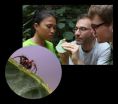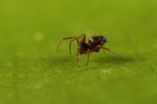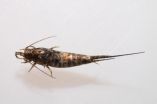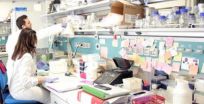(Press-News.org) As a spin-off (pun intended) of their Tropical Biodiversity course in Malaysian Borneo, a team of biology students discover a new spider species, build a makeshift taxonomy lab, write a joint publication and send it off to a major taxonomic journal.
Discovering a new spider species was not what she had anticipated when she signed up for her field course in Tropical Biodiversity, says Elisa Panjang, a Malaysian master's student from Universiti Malaysia Sabah. She is one of twenty students following the course, organised by Naturalis Biodiversity Center in The Netherlands, and held in the Danau Girang Field Centre in Sabah, Malaysian Borneo. The aim of the one-month course, say organisers Vincent Merckx and Menno Schilthuizen, is to teach the students about how the rich tapestry of the tropical lowland rainforest's ecosystem is woven.
Besides charismatic species, such as the orang-utans that the students encounter every day in the forest, the tropical ecosystem consists of scores of unseen organisms, and the course focus is on these "small things that run the world"—such as the tiny orb-weaving spiders of the tongue-twistingly named family Symphytognathidae. These one-millimetre-long spiders build tiny webs that they suspend between dead leaves on the forest floor. "When we started putting our noses to the ground we saw them everywhere," says Danish student Jennie Burmester enthusiastically. What they weren't prepared for was that the webs turned out to be the work of an unknown species, as spider specialist Jeremy Miller, an instructor on the course, quickly confirmed.
The students then decided to make the official naming and description of the species a course project. They rigged the field centre's microscopes with smartphones to produce images of the tiny spider's even tinier genitals (using cooking oil from the station's kitchen to make them more translucent), dusted the spider's webs with puffs of corn flour (also from the kitchen) to make them stand out and described the way they were built. They also put a spider in alcohol as "holotype", the obligatory reference specimen for the naming of any new species—which is to be stored in the collection of Universiti Malaysia Sabah. Finally, a dinner-time discussion yielded a name for this latest addition to the tree of life: Crassignatha danaugirangensis, after the field centre's idyllic setting at the Danau Girang oxbow lake.
All data and images were then compiled into a scientific paper, which, via the station's satellite link, was submitted to the Biodiversity Data Journal, a leading online journal for quick dissemination of new biodiversity data. Even though thousands of similarly-sized spider species still await discovery, Miller thinks the publication is an important one. "It means we provide a quick anchor point for further work on this species; the naming of a species is the only way to make sure we're all singing from the same score," he says.
Peter Schalk, Executive Secretary of Species 2000 / CoL, and GBIF Chair, comments: "This is a fine example of how the taxonomic world is embracing the digital era. Open data and rapid publication form the key for sharing information which in turn provides valuable input for responsible management of the world's biosphere. One of the most important achievements of this paper is that all data associated with this species have been harvested from the article and collated with other data
on GBIF and Encyclopedia of Life right on the day of publication, through a specially designed format called Darwin Core Archive. This is indeed a "real time" data publishing!"
Field station director Benoît Goossens adds: "This tiny new spider is a nice counterpoint to the large-mammal work we're doing and having it named after the field centre is extremely cool". The Danau Girang Field Centre is located in the Lower Kinabatangan Wildlife Sanctuary, a strip of rainforest along Sabah's major river, squeezed in by vast oil palm plantations on either side. Despite intensive search, the students could not find the new spider in the plantations.
INFORMATION:
Original Source:
Miller J, Schilthuizen M, Burmester J, van der Graaf L, Merckx V, Jocqué M, Kessler P, Fayle T, Breeschoten T, Broeren R, Bouman R, Chua W, Feijen F, Fermont T, Groen K, Groen M, Kil N, de Laat H, Moerland M, Moncoquet C, Panjang E, Philip A, Roca-Eriksen R, Rooduijn B, van Santen M, Swakman V, Evans M, Evans L, Love K, Joscelyne S, Tober A, Wilson H, Ambu L, Goossens B (2014) Dispatch from the field: ecology of micro web-building spiders with description of a new species. Biodiversity Data Journal 2: e1076. DOI: 10.3897/BDJ.2.e1076
More information:
On the spider and its significance: Jeremy Miller, Naturalis Biodiversity Center, Leiden, The Netherlands: jeremy.miller@naturalis.nl; tel: +31-6-81267400
On the Danau Girang Field Centre: Benoît Goossens, Cardiff University and Sabah Wildlife Department: goossensbr@cardiff.ac.uk; tel: +60-12-8364005
The following students may be contacted for interviews on their experience during the field course: Delft University student Lot van der Graaf: 00-31-6-47848050; lotvandergraaf@outlook.com; Leiden University student Roderick Bouman: 00-31-6-12369920; roderick_bouman@hotmail.com; Universiti Malaysia Sabah student Elisa Panjang: 00-60-12-8190817; elisa_panjang@yahoo.com
Joint press release by: Naturalis Biodiversity Center, Danau Girang Field Centre, Sabah Wildlife Department, Pensoft Publishers END
Students on field course bag new spider species
2014-03-27
ELSE PRESS RELEASES FROM THIS DATE:
The first insects were not yet able to smell well
2014-03-27
This news release is available in German. An insect's sense of smell is vital to its survival. Only if it can trace even tiny amounts of odor molecules is it is able to find food sources, communicate with conspecifics, or avoid enemies. According to scientists at the Max Planck Institute for Chemical Ecology in Jena, Germany, many proteins involved in the highly sensitive odor perception of insects emerged rather late in the evolutionary process. The very complex olfactory system of modern insects is therefore not an adaptation to a terrestrial environment when ancient ...
One gene, many tissues
2014-03-27
Genes are the "code" for building the biological elements that form an organism. The DNA that makes up genes contains the instructions to synthesise proteins, but it's wrong to think that, for a given gene, these instructions are always the same for all parts of the organisms. In actual fact, the gene varies depending on the tissue where it is located (cerebral cortex, cerebellum, olfactory epithelium, etc.); in particular, what varies is the point in the "string" of code at which protein synthesis starts. This complexity complicates the work of scientists considerably, ...
How size splits cells
2014-03-27
One of the scientists who revealed how plants "do maths" can now reveal how cells take measurements of size. Size is important to cells as it determines when they divide.
In a paper published in eLife, Professor Martin Howard from the John Innes Centre and colleagues from the US, Germany and Singapore discovered that cells measure their surface area using a particular protein, cdr2p. The finding challenges a previous model suggesting that another protein called pom1p senses a cell's length.
"Many cell types have been shown to reach a size threshold before they commit ...
Natural plant compounds may assist chemotherapy
2014-03-27
Auckland, New Zealand. 27 March 2014...Researchers at Plant & Food Research have identified plant compounds present in carrots and parsley that may one day support more effective delivery of chemotherapy treatments.
Scientists at Plant & Food Research, working together with researchers at The University of Auckland and the National Cancer Institute of The Netherlands, have discovered specific plant compounds able to inhibit transport mechanisms in the body that select what compounds are absorbed into the body,and eventually into cells. These same transport mechanisms ...
Smoke-free air policies seem to protect the heart
2014-03-27
WASHINGTON (March 27, 2014) — A new study on the impact of Michigan's statewide smoking ban adds to mounting evidence that policies prohibiting tobacco smoking in workplaces and other public spaces may substantially improve public health by reducing heart disease and death, according to research to be presented at the American College of Cardiology's 63rd Annual Scientific Session.
Studies on previous indoor smoking bans have consistently shown a major decrease in hospital admissions for heart attacks after smoke-free laws went into effect. Secondhand smoke exposure is ...
The heart responds differently to exercise in men vs. women
2014-03-27
WASHINGTON (March 27, 2014) — The formula for peak exercise heart rate that doctors have used for decades in tests to diagnose heart conditions may be flawed because it does not account for differences between men and women, according to research to be presented at the American College of Cardiology's 63rd Annual Scientific Session.
The simple formula of "220 minus age" has been widely used to calculate the maximum number of heart beats per minute a person can achieve. Many people use it to derive their target heart rate during a workout. Doctors use it to determine how ...
Cholesterol levels vary by season, get worse in colder months
2014-03-27
WASHINGTON (March 27, 2014) — Cholesterol levels fluctuate based on the time of year with more unfavorable lipid profiles seen in the colder months, a trend that may be driven by related behavior changes, according to research to be presented at the American College of Cardiology's 63rd Annual Scientific Session.
While previous studies have shown that heart attacks and heart-related deaths increase during the winter months, researchers at Johns Hopkins Ciccarone Center for the Prevention of Heart Disease were interested in finding out whether cholesterol parameters might ...
Mediterranean diet may lower risk of diabetes
2014-03-27
WASHINGTON (March 27, 2014) — Adoption of a Mediterranean diet is linked to a lower risk of diabetes, especially among people at high risk for cardiovascular disease, according to research to be presented at the American College of Cardiology's 63rd Annual Scientific Session.
Data from the first pooled analysis of studies evaluating the possible role of the Mediterranean diet on diabetes development show that adherence to this diet was associated with a 21 percent reduced risk of diabetes as compared to the control dietary groups. This reduced risk was even more pronounced ...
Marathon training could help the heart
2014-03-27
WASHINGTON (March 27, 2014) — Marathon training is associated with improved risk factors related to cardiovascular disease among middle-aged recreational male runners, suggesting that race preparation may be an effective strategy for reducing heart disease risk, according to research to be presented at the American College of Cardiology's 63rd Annual Scientific Session.
Over the last decade, marathon participation has risen steadily among middle-aged people seeking the reported health benefits of regular physical exercise. Some studies have shown that older men are significantly ...
More severe heart disease found in patients with vitamin D deficiency
2014-03-27
WASHINGTON (March 27, 2014) — Vitamin D deficiency is an independent risk factor for heart disease with lower levels of vitamin D being associated with a higher presence and severity of coronary artery disease, according to research to be presented at the American College of Cardiology's 63rd Annual Scientific Session.
A growing body of research shows that vitamin D may be beneficial in preventing heart disease. Several recent studies also support the idea that low levels of vitamin D are linked to an increased risk of heart disease; however, it is still not clear whether ...



